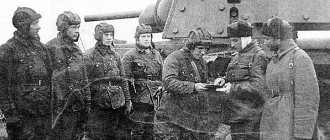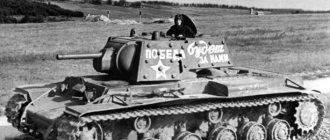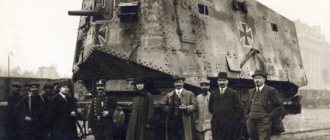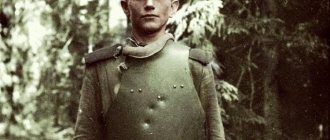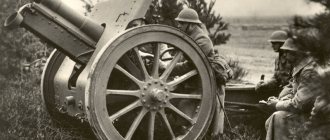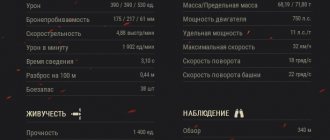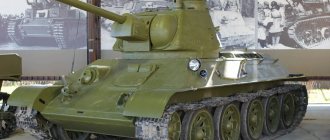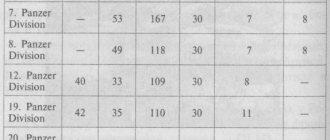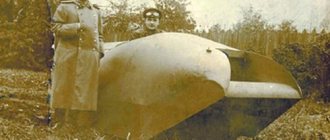KV-1 vs. “Dead Head” - first meeting
In the battles of the Great Patriotic War, which took place in the summer and autumn of 1941, it is very difficult to reconstruct the picture of events. Soviet documents on this period are few, fragmentary and often very contradictory. Many heroes who gave their lives defending the country from the enemy at the beginning of the war will remain unknown. But the author of this article was able to reconstruct the events of one of these battles, which took place on August 31, 1941. We are talking about the battle in the village of Vasilyevshchina between one of the regiments of the SS division “Totenkopf” and a company of Soviet KV-1 tanks, which the Germans encountered for the first time. The survivability of these vehicles amazed the soldiers of the SS anti-tank units, but poor coordination of actions did not allow the Red Army soldiers to achieve success in this battle.
Fortune telling from photographs
The reconstruction of this episode began with a series of photographs discovered in the German segment of the electronic auction eBay. The photographs showed a destroyed Soviet KV-1 tank standing against the wall of a village house. The photographs were taken from different angles and at different times. Thanks to them, it was possible to establish that the photographs depict a shielded vehicle produced by the Kirov plant in July 1941.
A damaged KV-1 near the wall of a destroyed house.
In some photographs, German soldiers posed on the car. By the characteristic camouflage clothing and the covers on their helmets, it can be determined that these soldiers belonged to SS units.
The same tank with SS soldiers
At first it was impossible to determine which SS division the soldiers belonged to. Subsequently, a photograph was discovered showing a report to an officer, whose rank, face and partially a buttonhole with a skull can be distinguished - this made it possible to determine the division and the identity of the officer. He turned out to be SS Sturmbannführer Martin Stange, commander of the 2nd division of the artillery regiment of the SS Totenkopf division.
The commander of the anti-tank guns that knocked out the KV-1 reports to Martin Stange
Subsequently, on one of the German historical forums, the grandson of a soldier of the SS division “Totenkopf” published a selection of photographs, among which was a photograph of this tank with a caption in which the toponym “Vasilievshchina” was indicated. The only village with this name, located in the zone of action of the SS Totenkopf division in the summer and autumn of 1941, is located in the interfluve of the Lovat and Pola rivers, 35 kilometers southeast of Staraya Russa, on the Pola - Demyansk road.
In that place, German troops crossed the Lovat River and entrenched themselves in the area between the Lovat and Pola rivers. This posed a threat to the 11th and 34th Soviet armies of the Northwestern Front, so it was important to drive the Germans back and restore defenses along the Lovat line. It is known that these attempts were unsuccessful - the Germans broke through the defenses and were able to encircle units of the 11th, 27th and 34th armies in the Demyansk area by the evening of September 8, 1941.
The combat journey of the KV-1 tank, captured in photographs, ended a week and a half earlier - on August 31. Documents from the two opposing armies finally clarified what happened to him. On the last day of summer, the tank took part in the attack of three KV-1s of the 87th separate tank battalion (87th OTB, in some documents it is called OTTB - a separate heavy tank battalion) on the position of the 1st regiment of the SS division "Totenkopf" in the village of Vasilyevshchina, located between Staraya Russa and Demyansk. That's how it was.
Fight: plan and reality
On August 31, 1941, exactly at midnight, on the basis of an order from the chief of staff of the 11th Army, a platoon of KV tanks consisting of three vehicles under the command of Senior Lieutenant Kvashnin was transferred to the disposal of the 183rd Infantry Division. By order of the commander of the 183rd Rifle Division, the arriving tanks were assigned to the 285th Infantry Regiment (SP) and were given the task of capturing the village of Vasilyevshchina and subsequently conducting an attack on the village of Byakovo. The attack was planned for the morning of August 31st.
The 285th Infantry Regiment had recently arrived in the area and knew nothing about the minefields laid by its predecessors in front of the tank advance. The units that were replaced by the 285th joint venture simply forgot to inform them that they had mined the bank and the crossing of the Pola River. Looking ahead, we note that it was this miscalculation that largely predetermined the failure of the operation.
Fragment of a topographic map of the Red Army of 1941
The KV's attack plan was simple: advance along the road connecting the villages of Rykalovo and Vasilyevshchina. The first tank under the command of Lieutenant Surin was supposed to go to the left of the road and, not reaching 500 meters from the village, turn to its eastern outskirts. Following along the same route was the KV of the company commander, Senior Lieutenant Kvashnin, who commanded the platoon in this battle. Finally, the third tank, under the command of Lieutenant Yarygin, was to advance on a parallel course to the right of the road. When moving out of positions and on the move, the tanks were supposed to fire from their guns, suppressing machine-gun and mortar positions of the Germans, and machine-gun fire was supposed to be fired at groups of enemy infantry from the tanks. The infantry of the 285th Infantry Regiment was supposed to support the tank attack. After the tank platoon occupied Vasilyevshchina, all three tanks were supposed to reunite on the northern outskirts of the village. The attack was scheduled for 11.00.
But everything went wrong.
At 10:45 the tanks began shelling the German positions from their guns. Taking the shelling as the beginning of the operation, the infantry of the 285th Infantry Regiment launched an attack (the strength of the regiment at that time was slightly less than a battalion). The Germans responded by opening heavy machine-gun fire and forcing the infantry to lie down.
At 11:00 three KV tanks with armored troops moved out from their original positions. The tank offensive was carried out according to plan, but the infantry, having suffered losses from machine gun fire, did not go on the attack. A German artillery forward observer immediately signaled a tank attack by firing a special rocket launcher cartridge that made a loud whistle in flight. After this, Lieutenant Surin’s lead tank was taken under fire from 37-mm anti-tank guns (3.7 cm Pak), but they were unable to have any effect on the movement of the well-armored tank. But they managed to do this with mines installed by their own brothers in arms...
Having passed only 150 meters, Lieutenant Surin’s tank ran into a mine that had been laid earlier by Red Army sappers. As a result, two tracks of this KV were broken and the rollers were damaged, so the tank was temporarily unable to move. In addition, machine-gun fire was concentrated on him, forcing the landing party to jump off the armor and lie down. Even while under fire, the crew was able to repair the damage in 25 minutes, but due to the loss of time, the tank was unable to continue participating in the attack and was ultimately forced to retreat.
The tank of the unit commander Kvashnin bypassed the “colleague” who had been blown up and began to advance towards Vasilyevshchina, but before reaching 500 meters from the village it ended up in someone else’s minefield (the Germans set it up at night), was blown up and also lost speed. When the crew of the first KV was able to repair the broken tracks, he drove forward and took the commander’s tank in tow, after which he pulled it to its original positions, hiding behind a smoke screen. At the same time, the tanks were subjected to constant fire from small arms and anti-tank guns: several 37-mm and one 50-mm anti-tank gun (5 cm PaK 38) of the third platoon of the first battery of the SS anti-tank division “Totenkopf”.
German map of the defense of Vasilyevshchina on August 31, 1941
In this battle, the Germans encountered Soviet KV tanks for the first time. In their reports after this battle, they noted the good survivability of the tanks. The Soviet commander's KV was motionless in a minefield at a distance of only 300 meters from the positions of German anti-tank forces. As the tug tank approached, the Germans hit it four times with a 50-mm cannon, which caused a fire in the turret, but even this could not prevent the Soviet tank crews from removing both tanks from the battle.
One against all
So, the tanks of Kvashnin and Surin left the battle - having been blown up by mines and receiving damage, they returned to their original positions. It remains to deal with the KV under the command of Lieutenant Yarygin, who was walking alone on the right side of the road from Rykalovo to Vasilyevshchina. As you might guess, the fate of the tank turned out to be unenviable - it was he who later became the subject of photographs posted on eBay with posing SS men.
Lieutenant Yarygin with the crew of his KV continued the assault on Vasilievshchina alone: the infantry lay down, the tanks of his comrades were blown up, and the troops jumped from the armor due to machine-gun fire.
It is still not clear why Lieutenant Yarygin, seeing the problems of the other two tanks, decided to storm Vasilyevshchina alone. The combat report of company commander Kvashnin, whose KV was towed away by Lieutenant Surin’s tank after being blown up by a German mine, says that Yarygin’s tank “did not return back to its original positions for an unknown reason.”
Following the original plan, KV Yarygina reached the positions of the German infantry, “ironed” them and broke into the village, crushing a German heavy machine gun with a machine gunner in the process. At this time, a German 37-mm anti-tank gun from the heavy weapons company of the 1st SS Division “Totenkopf”, camouflaged near the outermost house of the village, opened fire on him from close range. The fire from this cannon did not harm the KV, but these actions had dire consequences for the Germans - the cannon was discovered, pressed against the house and crushed.
But this sacrifice of the German artillerymen was not in vain. To destroy the cannon, the KV turned its head towards the house, exposing the rear part to fire. The German artillerymen of the second 50-mm anti-tank gun from the 1st SS Totenkopf battalion took advantage of this. They pulled their gun to a new position to fire at the stern of the KV. Despite the fact that the Soviet tank crews noticed the threat, managed to deploy the turret and open fire from a coaxial machine gun, the Germans were able to fire first and damage the KV gun, which saved the crew of the German gun from destruction. After this, the Germans took the tank, which had lost its main destructive power, under heavy fire.
German diagram from a report showing the movement of a Soviet tank and the maneuvering of German artillery in a village
The final denouement came when the commander of the 1st platoon of the SS anti-tank division climbed onto the smoking, silent tank and stuck an M-24 grenade into the gun barrel. The explosion of a grenade opened the turret hatch. The entire crew of the Soviet tank died in battle. After the battle, the Germans counted 18 hits in Lieutenant Yarygin’s HF, 3 of which were through.
In the report, the commander of the German battery wrote about how the KV was destroyed:
38 shots were fired with armor-piercing shells (Pz . Gr.40 ). As a result, the driver's cabin and the tower were pierced. A hit in the driver's wheelhouse disabled the tank; the crew presumably died as a result of a fire caused by the ignition of ammunition after being hit by an armor-piercing shell ( Pz . Gr.40 )
.
Despite the local victory, the SS men were not pleased with the discoveries made during the battle:
«….
a) The distance for effective firing at 52-ton tanks with armor-piercing shells ( Pzgr . 40) is no more than 200 m.
b) The rounded protrusion on the upper part of the stern is the most vulnerable spot of 52-ton tanks.
Armor: approximately 3 cm, very difficult to penetrate
».
To be remembered
According to documents 58 of the TsAMO fund, containing lists of irretrievable losses, the crew of the tank was identified as Lieutenant Vasily Emelyanovich Yarygin:
- Rulkov Andrey Ivanovich, sergeant, gun commander;
- Shop foreman Ivan Naumovich, sergeant, senior radiotelegraph operator;
- Temnov Georgy Vasilievich, corporal, senior mechanic-driver;
- Kononov Stepan Petrovich, Red Army soldier, mechanic.
Yarygin himself graduated from the 2nd Saratov Tank School in June 1941 as a platoon commander of a heavy tank battalion. Soon after this, he was sent to receive new equipment at the Kirov plant, and from there he, along with the tank, ended up on the North-Western Front. He only managed to fight for a little over a month...
Lieutenant Yarygin Vasily Emelyanovich, photo taken after leaving the tank school for the front in June 1941
This is how, from the documents, we were able to find out the circumstances of the unsuccessful attack on Vasilyevshchina, identify the crew of the tank and shed light on its fate.
The second time Vasilyevshchina became the scene of fierce battles in the spring of 1942 and was completely destroyed. Yarygin’s tank stood at the site of destruction for a long time and continued to be captured by German soldiers.
A grave is visible near the rollers of the damaged KV. The inscription on the sign is impossible to read. Perhaps this is the crew of the tank, but more likely the SS soldiers who died in battle with it
Now at the site of the last battle of the KV-1 there is a wooden residential building, which was built on the site of the old one indicated on the German diagram. From a conversation with the residents, it turned out that they moved to this place after the war and built on the old foundation - therefore, there are obvious similarities between the modern house and the house from the German photographs.
Photo of a house in the village of Vasilyevshchina, next to which there was a damaged KV. The top photo is from 2013, the bottom photo is from 1941.
It is known that V. E. Yarygin’s relatives tried to establish his fate, but did not leave their contacts anywhere. If any of them have read this material, please contact the editors or the author of the article.
List of sources:
- NARA T354 R133
- TsAMO F. 357 Op. 5971 D. 7
- TsAMO F. 87 OTB Op. 4678 D.3
- TsAMO F. 58 Op. 818884 D. 48
- TsAMO F. 221 Op. 1364 D. 84
- TsAMO F. 25TP Op. 404064 D. 73
- TsAMO F. 38 Op. 11355 D. 321
- TsAMO F. 38 Op. 11355 D. 36
- TsAMO F. 103 OTB Op. 294930 D.1
In one battle, he destroyed a column of 22 tanks: the story of a Russian ace - one of the most successful in the world
The commander of the KV-1 tank, Zinoviy Grigorievich Kolobanov, destroyed a German tank column of 22 tanks in the battle near Voyskovitsy and went down in history as one of the most successful Soviet tank aces of World War II.
On August 20, 1941, the crew of the KV-1 tank destroyed a German tank column of 22 tanks in a battle near the Voyskovitsy state farm in the Krasnogvardeisky (now Gatchina) district of the Leningrad region. This battle, led by senior lieutenant tank commander Zinovy Kolobanov, went down in history as one of the most successful in World War II.
The crew, in addition to Kolobanov, included the gun commander, senior sergeant Andrei Mikhailovich Usov, senior mechanic-driver, foreman Nikolai Ivanovich Nikiforov, junior mechanic-driver, Red Army soldier Nikolai Feoktistovich Rodnikov, and gunner-radio operator, senior sergeant Pavel Ivanovich Kiselkov.
On the eve of the battle, Kolobanov received an order to cover three roads leading to Krasnogvardeysk from Luga, Volosov and Kingisepp (via the Tallinn highway): “Block them and stand to the death!” The commander's company of five tanks advanced to meet the enemy. It was impossible to let the German tanks through - they planned to achieve the goal at any cost, including their own lives. Each Russian tank was loaded with two rounds of armor-piercing shells and a minimum amount of high-explosive fragmentation shells.
In the afternoon of August 20, the crews of Lieutenant Evdokimenko and Junior Lieutenant Degtyar were the first to meet a German tank column on the Luga Highway, chalking up five enemy tanks and three armored personnel carriers. Then, at about 14:00, after an unsuccessful aerial reconnaissance, German reconnaissance motorcyclists followed along the seaside road to the Voyskovitsy state farm, whom Kolobanov’s crew let through without hindrance, waiting for the main enemy forces to approach. Light tanks of the German 6th Panzer Division moved in the column. After waiting until the lead tank of the column reached two birch trees on the road, Kolobanov commanded: “First landmark, at the head, direct shot under the cross, armor-piercing - fire!” After the first shots from gun commander Usov, a former professional artillery instructor and participant in the war in Poland and Finland, the three lead German tanks caught fire, blocking the road.
Then Usov transferred the fire to the tail, and then to the center of the column, thereby depriving the enemy of the opportunity to retreat back or towards Voyskovits. On a narrow road, on both sides of which there was a swamp, a crush formed: cars, continuing to move, bumped into each other, moved to the side of the road and ended up in the swamp, where they completely lost mobility and could only fire from the towers. The ammunition in the burning enemy tanks began to explode. The German tank crews returned fire, and even all the enemy tanks stuck in the swamp had to be suppressed by fire. 114 German shells hit the turret of Kolobanov’s tank. But the armor of the KV turret has proven itself from the best side. In 30 minutes of battle, Kolobanov’s crew knocked out all 22 tanks in the column. 98 armor-piercing shells were used from the double ammunition load. After the battle, more than a hundred hits were counted on Kolobanov’s KV-1!
Thus, as a result, the crew of Senior Lieutenant Z.G. Kolobanov was hit by 22 German tanks, and in total his company chalked up 43 enemy tanks. In addition, battalion commander Shpiller personally burned two tanks. On the same day, the company destroyed one passenger car, an artillery battery, up to two infantry companies, and captured one enemy motorcyclist.
Maxim Kolomiets
SOVIET HEAVY TANK KV-1
The first Victory tanks
Volume 1
Tank KV-1 manufactured in 1942 (with a cast turret) in position. 1942, Kalinin Front (RGAKFD).
INTRODUCTION
The book offered to readers is the first attempt, as they say, “under one cover,” to tell more or less in detail about the history of the creation, production, variants and combat use of the KV-1 heavy tank. In this work, both the author’s previously published works on this topic (with changes and additions) and previously unpublished documents and materials were used. Much attention is paid to the production of KV-1 tanks in Chelyabinsk, at the famous “Tankograd”. The author tried to tell in what difficult and difficult conditions workers, technicians and engineers worked in the rear, supplying the Red Army with heavy tanks. After all, there was literally a shortage of everything - metal, machine tools, materials for brake bands. We had to look for various, including non-standard, ways out of the current situation. Sometimes this led to a decrease in the quality of products, but there were simply no other ways, and the front needed tanks.
In general, now they write and talk about the work of the rear during the Great Patriotic War much less than before. But the feat of the workers on the labor front was no less than that of the soldiers on the battlefield. And after all, at the factories, including at Tankograd, women and teenagers worked alongside men, and even on starvation rear rations! And they worked, despite the most difficult conditions, cold and poor nutrition, and produced the tanks needed by the front.
And how the HF was assembled and repaired at plant No. 371 named after Stalin in besieged Leningrad - the mind generally refuses to understand. At one time, in the mid-1990s, the author had to visit an enterprise in St. Petersburg. Times were difficult, production was barely going, and some of the workshops were not heated (this was in February). It was still a pleasure! When I was collecting material on the production of KV in besieged Leningrad, I remembered that long-ago trip, and I thought - how did people, exhausted from hunger, work then? But they worked and repaired tanks and assembled, albeit with great difficulty, new KVs.
A significant volume of the book is occupied by information about the organizational structure of KV-1 tank units, the personnel training system for them and combat use. Naturally, it is not possible to talk about all the units that were armed with the KV-1 in the space of a book. Information is provided on the most interesting, from the author’s point of view, episodes and operations in which KV-1 tanks were actively used. For example, an analysis is given of the actions of the KV-1 on the Crimean Front in the first half of 1942 - many publications indicate that during these battles the KV-1s failed en masse, but no details are given on this topic. The author decided to talk in more detail about this episode.
As for the description of the design and structure of the KV-1 tank, it is given in a rather condensed volume. Anticipating questions from fans of nuts and bolts (people involved in the construction of tank models or simply interested in the evolution of the KV-1 design over different periods of production), I would like to say that detailed information about when certain changes were introduced into the design of the tank has not yet been found managed. There is similar information on pre-war HF production, and partly at the beginning of the war in relation to vehicles produced in Leningrad. But for the KV-1 produced by the Chelyabinsk Kirov Plant there are fewer such materials. Therefore, information is provided only on changes to some components and assemblies. And the “parsing” of the KV-1 into individual components, indicating all the options for the rollers, tracks, options for turrets, hulls, hatches, etc., used is a topic for a separate study.
This book could not have been published without the help of my friends and colleagues, who helped at various stages of the work.
First of all, many thanks to my friend Alexander Smirnov from St. Petersburg for his help with documents and valuable advice and comments.
I would also like to thank Ilya Mazurov (Krasnoyarsk), who not only provided materials on the history of the KV-1, but also expressed a number of interesting ideas and considerations during the discussions.
Special thanks to Dmitry Surkov for translations from German, as well as Vitaly Tarasov for working with personalities and Alexey Volkov for the story with Lieutenant Pashinin.
If anyone has any additions to any parts of the book, please write to
TANK DEVELOPMENT
The Spanish Civil War showed that tanks had a dangerous enemy - small-caliber, rapid-fire anti-tank artillery. As a result, the T-26 and BT-5 tanks supplied from the USSR to the republican government suffered significant losses.
The leadership of the Red Army responded to messages from Spain quite quickly, deciding to begin developing tanks (primarily heavy ones) with ballistic armor. In July 1937, the Red Army Automotive and Tank Directorate issued plant No. 183 in Kharkov with tactical and technical requirements for the development of a new version of the heavy five-turret T-35 tank weighing up to 60 tons with armor of 40–75 mm.
But the very first calculations and preliminary studies of such a vehicle, carried out in the design bureau of plant No. 183, showed that it was impossible to create a multi-turret tank with a given armor thickness and weight. According to engineers' estimates, it was a heavy vehicle weighing 80–90 tons, which also had very low mobility. In addition, the design bureau of plant No. 183, already small, was overloaded with work on ensuring mass production of the BT-7 and T-35, designing a new wheeled-tracked tank and a diesel engine.
As a result, according to the decision of ABTU KA, agreed with the Defense Committee of the Council of People's Commissars of the USSR[1], the development of a heavy tank with anti-ballistic armor was entrusted to two design bureaus - SKB-2 of the Kirov plant and design bureau of plant No. 185 named after Kirov. The choice was not made by chance - the Leningrad Kirov Plant carried out mass production of medium three-turreted T-28 tanks, and the designers of Plant No. 185 had extensive experience in designing new types of combat vehicles, since the early 1930s they had been designing, manufacturing and testing various prototypes of tank weapons. For example, the designers of Plant No. 185 created such models of combat vehicles as the T-28, T-35, T-29, T-46, T-43 tanks, SU-5, SU-6, SU-14 self-propelled guns and much more.
Both companies received the task of designing a three-turreted tank with projectile-proof armor weighing up to 60 tons. However, since it was not fully understood what kind of machine the Red Army needed, the designers of both factories could only carry out preliminary studies, focusing on the given parameters and their imagination.
On August 7, 1938, a meeting of the Defense Committee of the Council of People's Commissars of the USSR was held in Moscow, which was attended by representatives of the General Staff, ABTU KA, People's Commissariats of Medium and Heavy Engineering, "tank" design bureaus and factories. It resolved one question: what tanks does the Red Army need in the near future? As a result of the discussion, on the same day, Defense Committee Resolution No. 198ss, entitled “On the Tank Weapon System of the Red Army,” was adopted. Regarding heavy tanks, this document said the following:
"1. The breakthrough tank (anti-tank fighter) of the tracked type is manufactured according to the tactical and technical data of the ABTU, developed on the basis of the Tank Conference and approved by the People's Commissar of Defense (Appendix No. 1).
a) Oblige NKMash to manufacture and transfer to the NPO for testing a prototype of a breakthrough tank by May 1, 1939.
return 1
The Defense Committee under the Council of People's Commissars (SNK) of the USSR was created on April 23, 1937 to unite “all activities and issues of defense of the USSR” consisting of seven people: V. Molotov (chairman), I. Stalin, L. Kaganovich, K. Voroshilov, V. Chubar, M. Rukhimovich and V. Mezhlauk. He served as coordinator of the activities of the leadership of the armed forces and industry (people's commissariats) on issues of mobilization plans, the production of military equipment and preparing the country for defense. At its meetings, among other things, issues regarding the development of new types of tanks and their adoption were resolved.
HEROES TANKERS
HEROES TANKERS
A tank, even one as powerful as the KV-1, without a crew is simply a stationary machine, incapable of any action. What makes it a formidable weapon is the crew, and the result of a tank battle depends on the actions, skill and courage of the latter. Among the tankers who fought on the KV-1 there were many heroes, some of them were mentioned in the above chapters. But I would like to say separately about the most striking, in the author’s opinion, episodes involving the crews of the Kaveshkas.
The first of them, without a doubt, is the so-called “Raseiniai KV”. This story became quite widely known in our country in the second half of the 1990s.
The famous “Raseiniai KV” at the battle site. June 25, 1941 (ASKM).
The notorious author V. Rezun (better known as Viktor Suvorov) wrote about this in particular in his book “The Last Republic”. He informed readers that in June 1941, near the Lithuanian town of Raseiniai, one KV tank delayed the advance of the entire 4th Panzer Group for a day. But this episode was known abroad for quite a long time; already in 1950–1953 there were publications devoted to it. They wrote about this story later.
In recent years, a significant amount of Soviet archival materials have been declassified, and it has become possible to work with documents from the German side. This made it possible to study the history of the famous “Raseiniai KV” more clearly and in detail.
As a result, with 100% certainty (this is confirmed by archival documents, this will be discussed in more detail in the author’s book on the history of the Raseiniai tank battle), we can say that this battle took place between KV-1s from the 4th Tank Regiment of the 2nd Tank Division, General -Major E.N. Solyankin, and the battle group of Routh from the 6th Panzer Division of the Wehrmacht north of the town of Raseiniai in Lithuania on June 24–25, 1941. A brief chronology of events is as follows.
On the afternoon of June 23, 1941, after the capture of Raseiniy by the 6th Panzer Division of the Wehrmacht, it continued its offensive along two roads with two battle groups (Raus and Zeckendorf, according to the names of the commanders). The groups soon took up bridgeheads on the northern bank of the Dubisa River, approximately 8 kilometers apart. On the morning of June 24, the approaching units of the 2nd Tank Division of the Red Army directly from the march attacked the positions of the Seckendorf group, which received the main blow. It was here that the enemy first encountered the KV tanks available in Solyankin’s division. The documents of the 6th Panzer Division say about these vehicles: “52-ton new tanks, type not determined.”
German tank crews inspect the Raseiniai KV. June 25, 1941. On the rear of the vehicle there is an inscription in chalk stating that it was destroyed by the crew of gun D of the 2nd battery of the 1st division of the 3rd anti-aircraft regiment (YaM).
It turned out that the German anti-tank artillery could not penetrate their armor, which caused panic in some units. The Germans were driven out of the bridgehead, and at 14.00 Zeckendorf requested help from the commander of the 6th division, General F. Landgraf. The latter, having transferred all available reserves to the zone of the Zeckendorf group, turned for help to the headquarters of the 41st Panzer Corps. As a result, the German command threw all four divisions of the corps against Solyankin's division. As a result, one of the major tank battles of the beginning of the war unfolded in the vicinity of Raseiny. During its course, Solyankin's 2nd Tank Division alone, without neighbors, rear lines or normal supplies, delayed the German tank corps for two and a half days. True, this came at a high price - the division was surrounded, suffered heavy losses, and its commander died in battle.
During the first, most difficult day for the Germans, of the battle, Routh's battle group was busy trying to destroy the only KV-1, which cut the road to Raseiniai and actually cut it off from the main forces of the division. For reference, according to the most conservative estimates, Routh’s group consisted of about 2000 people, about more than 40 guns of 37-150 mm caliber.
According to the documents, the KV went to the rear of the group at approximately 14.00 on June 24. The car shot at several cars and stopped on the road (later it turned out that the tank had run out of fuel). First, two 50-mm anti-tank guns were deployed against the KV. However, their fire could not destroy the tank, and the KV's retaliatory shots destroyed both guns, killing and wounding several people.
Routh's group requested assistance from the headquarters of the 6th Panzer Division, and one 88-mm anti-aircraft gun was moved towards the tank from Raseiny. But when trying to deploy the gun at a distance of about 500 meters from the KV, the latter opened fire and disabled the gun. At the same time, there were also casualties among the artillerymen.
Meanwhile, the situation was developing very unfavorably for the Rous group. Vehicles with ammunition and food could not get through to it, and it was impossible to remove the wounded from the bridgehead. Attempts to drive around the tank were unsuccessful - the terrain to the right and left of the road was impassable for cars.
After 20.00, a team of sappers was formed in the Rous group, who were tasked with destroying the KV. They managed to get close to the tank, throwing two explosive charges on it with a total mass of 15 kilograms, but the explosion did not produce any tangible results.
The crew of the KV-1 tank 3. G. Kolobanova (in the center) at their combat vehicle. Leningrad Front, August 1941 (TsMVS).
On the morning of June 25, the Germans launched a demonstration attack against the KV with their Pz.35 (t) tanks, under the cover of which they managed to deploy 88-mm anti-aircraft guns from the 3rd Anti-Aircraft Regiment into positions. Only their fire managed to disable the KV-1, whose crew died. This happened at approximately 11:00 on June 25, 1941. Thus, the lone KV occupied positions on the road for a little more than 20 hours, causing Routh’s group, and the 6th Panzer Division, a lot of trouble.
This battle with a single KV made a strong impression on the Germans. Later, in his memoirs “Tank Battles on the Eastern Front,” the former group commander E. Rous devoted 25 pages from a 456-page book to this episode (if desired, anyone can read these memoirs - they are translated into Russian). At the end of the episode, Routh wrote:
“Inside the tank lay the bodies of the brave crew, who had previously only received injuries. Deeply shocked by this heroism, we buried them with full military honors."
In 1965, the tank crews were reburied at the military cemetery in Raseiniai. During the exhumation, a receipt issued to Pavel Egorovich Ershov and two spoons were found, on one of which Smirnov V.A. was scratched, and on the second - Sh.N. A. And even though the names of all the members of the heroic crew of the “Raseiniai KV” are unknown today, we have no right to forget about their feat. After all, these tankers fulfilled their duty and military oath to the end. They did not give up and did not run away, but until the very end they honestly did their job, which is what they were taught. They forced the enemy to respect both themselves and the army in which they served.
The second example of heroic actions is the crew of Zinovy Kolobanov. Zinovy Grigorievich Kolobanov was born on December 25, 1913 in the village of Arefene, Vachevsky district, Nizhny Novgorod province. He graduated from eight-year school, after which he entered a technical school, from where in 1933, according to the Komsomol recruitment, he was drafted into the ranks of the Red Army. As someone who had a secondary education, he was sent to study at the Oryol Tank School named after M.V. Frunze, from which he graduated with honors in 1936. After that, he served in tank units of the Leningrad Military District. In 1939–1940, Lieutenant Kolobanov, as a company commander of the 1st Tank Brigade, participated in the Soviet-Finnish War. After the war, he served in the Kiev Special Military District, and in September 1940 received the rank of senior lieutenant.
The crew of the shielded KV-1 (produced in June 1941) discusses the results of the battle. Northern Front, August 1941 (RGAKFD).
On August 18, 1941, Kolobanov was appointed commander of a company of KV-11 tank tanks of the 1st Red Banner Tank Division. By this time, the regiment, commanded by Colonel D.D. Pogodin, was separated from the division and acted independently in the Krasnogvardeysk area. Kolobanov’s company was assigned to the 1st Guards Division of the People’s Militia. The vehicles were placed in ambush along the routes of the most likely enemy movement. Kolobanov's tank (gun commander senior sergeant A.M. Usov, senior mechanic-driver foreman N.I. Nikiforov, junior mechanic-driver Red Army soldier N.F. Rodnikov and gunner-radio operator senior sergeant P.I. Kiselkov) took a position near the populated area Voyskovitsy point, next to the highway going to Kingisepp. The crew dug out a caponier for the HF and carefully camouflaged the vehicle near the road. To the right and left of it was a swampy meadow, making it difficult for the enemy to maneuver.
At approximately 14.00 on August 20, 1941 (according to other sources, the battle took place on August 19), German motorcyclists followed along the road, whom Kolobanov’s crew let through. Soon a German tank column appeared.
With the first shots, gunner Usov managed to knock out two lead enemy vehicles. Then Usov transferred the fire to the tail of the column, depriving it of the opportunity to retreat back. There was a traffic jam on the road - some of the tanks were trying to move into a swampy meadow, others were trying to push off the damaged vehicles and clear a path for themselves.
However, under fire from KV Kolobanov, the enemy was unable to do anything. And the Soviet crew managed to knock out 22 German tanks during a 30-minute battle.
But the Soviet vehicle also suffered - as a result of the shelling, the KV's surveillance devices were disabled and the turret was jammed, and it was also running out of ammunition. However, the crew of 3. Kolobanov completed the task, delaying the German advance in this sector. After the battle, more than a hundred hits were counted on the armor of the Kolobanovsky KV.
At the beginning of September 1941, for this battle, the entire crew of 3. Kolobanov was nominated by the command of the 1st Tank Regiment for the title of Hero of the Soviet Union, but they were never awarded. Kolobanov himself and N.I. Nikiforov received the Order of the Red Banner, N.F. Rodnikov and P.I. Kiselkov - Order of the Red Star, and gunner A.M. Usov - Order of Lenin (the highest award of the USSR).
The award sheet for Zinovy Kolobanov for the presentation of the title Hero of the Soviet Union, dated September 2, 1941, says:
“On August 19, the tank of Senior Lieutenant Kolobanov ambushed and pushed forward the sentinels from among its crew, the latter at 14.00 on 20.8.41 reported the appearance of a tank column at the Voyskovitsy state farm. With the approach of the enemy's lead tank to the state farm, Comrade. Kolobanov gave the command to the artilleryman to open fire on the first and second enemy vehicles, which caught fire. Comrade Kolobanov gave the command to destroy the last two tanks in the column, which was carried out by the artilleryman. After this comrade. Kolobanov adjusted the artilleryman’s shooting at tanks, and the radio operator’s at enemy tank crews. During this time, the crew destroyed 22 enemy tanks, three motorcycles, and a total of comrade’s company. Kolobanov, 43 enemy tanks were destroyed.
The enemy, seeing heavy losses in their tanks, opened hurricane artillery and mortar fire at the site where Comrade’s tank was parked. Kolobanova. But it was too late, the tank took a new position and fired to destroy enemy firing points. By this time, there were 12 shells left in the tank, and it was necessary to go out to refuel. Taking with it 2 seriously wounded junior lieutenants and 5 wounded Red Army soldiers, the tank went out to refuel.
For heroism and courage shown in the battles against German fascism, comrade. Kolobanov is worthy of being awarded the title Hero of the Soviet Union.”
The award sheet for Senior Sergeant Usov said:
“Comrade Usov is the commander of the tank gun of Torah commander Comrade. Kolobanova. On August 20, 1941, a column of fascist tanks was discovered in the direction of the Voyskovitsa state farm. Comrade Usov opened accurate artillery fire on them. Having destroyed the two front tanks, Comrade. Usov, on the orders of the company commander, transferred the fire to the tail of the column. Having destroyed the last two tanks, Comrade. Usov transfers fire to the remaining fascist tanks. As a result of well-aimed fire, the crew destroyed 22 fascist tanks.
For the courage and heroism shown in the fight against German fascism, comrade. "Usov is worthy of the highest government award - the title Hero of the Soviet Union."
By the way, the commander of the 1st Tank Regiment Pogodin, in a report on the combat operations of his unit from August 16 to August 31, 1941, reported:
“Up to 40 enemy tanks in a column on the move to Bol. Bornitsa was met by our tank ambush with KV tanks. As a result of the battle, the KV tank of the 1st TB company commander, Senior Lieutenant Kolobanov, knocked out 22 enemy tanks...
When the ammunition was exhausted, Kolobanov’s tank withdrew to Gatchino.”
In recent years, at various military-historical forums and on the Internet, the question has been raised that Kolobanov’s crew did not knock out 22 tanks. Moreover, some “historians” express the opinion that such a battle never took place. The argument of such authors is that in German documents, access to which has become possible in recent years, there is no confirmation of such large losses in one day. However, according to the author, such argumentation is not correct. The fact is that most often data is provided from the combat logs of German divisions (LCD). But we shouldn’t forget that these magazines were written retroactively, and we shouldn’t discount the human factor - the one who wrote could simply “omit” something. And information about losses is not always contained in the concrete records. More detailed information may be contained in appendices to the ZhBD, but they are put into circulation very rarely. In addition, combat logs of tank regiments, which may contain more detailed information, have not yet been discovered. In general, according to the author, the Germans’ system for recording losses was rather crafty, and often lost tanks could be written off retroactively. Therefore, obtaining accurate data on how many vehicles were lost during a given day of fighting is an extremely difficult and often impossible task. But perhaps in the future German documents will be found and introduced into scientific circulation, which will finally dot the i’s.
According to the author, Kolobanov’s battle took place; it is unlikely that the regiment commander Pogodin came up with this and reported it in the reporting documents.
Tank KV-1 (with a welded turret, an armor ring protecting the rear machine gun mount and rollers with internal shock absorption), knocked out near Rzhev. Winter 1942 (ASKM).
What kind of tanks Kolobanov knocked out, and how many of them there really were, cannot yet be said for sure. It is possible that armored personnel carriers or half-track tractors with automatic anti-aircraft guns mounted on them were moving along with the tanks in the column. It is very doubtful that Senior Lieutenant Kolobanov has as detailed an understanding of the types of German equipment as his armchair critics, who today can easily distinguish, say, Pz.35(t) from Pz.III Ausf.G or Sd.Kfz 251 from Sd. Kfz 7/1. Looking at the enemy column through the periscope, Kolobanov hardly set out to determine what specific type of equipment was moving along the road. His task was to stop the enemy’s advance towards Leningrad, and the crew accomplished it brilliantly.
By the way, a number of researchers believe that enemy losses during the Kolobanov battle can still be found in German documents. For example, O. Skvortsov, in his article “Kolobanov’s “Unnoticed” Victory or “Blank Spots” in the Memoirs of German Generals,” citing calculations about the losses of the 6th Tank Division, writes:
“In other words, 41 tanks were actually irretrievably lost as of August 23. Thus, the irretrievable losses of Pz.Kpfw.35(t) from June 22 to August 3 amounted to 17 units, and from August 3 to August 23 - actually 24 units, of which 14 tanks, formally written off from August 23 to September 4, should definitely be attributed to the results of the battle with Kolobanov’s company.”
Other researchers believe that Kolobanov’s KV could in no way have fought the tanks of the enemy’s 6th Panzer Division, since it was advancing on Leningrad to the north, and he was fighting with the 1st Wehrmacht Panzer Division. In any case, this episode requires additional serious research. But be that as it may, this does not at all diminish the importance of the battle of the crew of Zinoviy Kolobanov, who delayed the German offensive in their sector and allowed them to gain time.
The crew of the KV-1 tank after the battle. Western Front, winter 1942 (CMVS).
Subsequently, he and his crew took part in the battles near Krasnogvardeysk. On September 15, 1941, Zinoviy Kolobanov was seriously wounded while refueling a tank - an exploding shell damaged his head and spine. He had to undergo treatment for a long time, but Kolobanov returned to duty again - on June 10, 1945, he was appointed deputy commander of the 69th tank battalion of the 14th mechanized regiment of the 12th mechanized division of the 5th Guards Tank Army. He served in the Armed Forces until July 1958, after which he was transferred to the reserve with the rank of lieutenant colonel. Lived in Minsk, worked at the Minsk Automobile Plant.
Zinoviy Grigorievich Kolobanov died on August 8, 1994. He was buried at the Chizhovsky cemetery in Minsk.
The third episode that I would like to tell readers about is the battle of Lieutenant Pashinin’s KV-1. The history of this tank was found in German documents and then double-checked in Soviet documents by my friend Alexei Volkov, who has been studying the history of the battles for Rzhev in 1942–1943 for many years. Alexey shared materials on this heroic, but little-known, episode.
A.S. Pashinin is a cadet of the 1st Kharkov Armored School (“Immortal Regiment”).
Information about this battle was first found in the combat log of the 18th Infantry Regiment of the 6th Wehrmacht Infantry Division about the battles in the area of the village of Polunino north of Rzhev in August 1942:
“...August 5 Night battle at the breakthrough site. Sappers from the 2nd company of the 6th sapper battalion dealt with the tanks that broke through. One was burned, the other was immobilized (the crew was alive and shooting back), the third managed to escape. Until dawn, the Russians fire harassingly, their plywood aircraft aimlessly bombing the “city forest.” They are also intensively bombing the city and especially the Volga bridges...
On the morning of August 8, the anti-tank group destroyed a tank in the positions of the 10th company, which was knocked out there on the night of the 4th to the 5th.”
Thus, according to German data, it turned out that the crew of the Soviet tank fought for three days!
In order to find in Soviet documents which tank was discussed in the German combat log, it took a year of work in the archive. Several tank brigades operated in that area, and the reporting on some of them left much to be desired.
The crew of the KV-1 tank from the 108th Tank Division receives a combat mission. Bryansk Front, September 1941 (ASKM).
However, the result was revealed in the affairs of the 143rd Tank Brigade of the 30th Army of the Kalinin Front:
“08/04/1942 the crew of Pashinin’s tank received the task, together with other tanks, together with the infantry, to attack the village of Talakhovo. Neither crazy art. Enemy fire and off-road conditions did not prevent the heavy Soviet fortress tank from moving forward. He walked ahead, and the others followed him.
Having left the starting position, the tank quickly burst into the front line of the enemy’s defense. The mechanic-driver, technical lieutenant Khaibulin, turned the car around and drove it along the front edge of the enemy’s defense, crushing the enemy’s infantry and guns with its tracks and armor. Senior Sergeant Bovt assisted him with machine gun fire. In total, in this attack the crew destroyed several bunkers, 3 machine guns, 3 cannons and one enemy mortar, more than a company of infantry.
But having wedged further into the depths of the enemy’s defense, the tank ran into a mine and lost mobility. The crew decided to restore the car no matter what. The sneaky enemy decided to get ahead of the crew's intentions. One of the Krauts jumped on the tank with a bottle of gasoline, wanting to set the tank on fire. Noticing this enemy attempt, the vehicle commander, Senior Lieutenant Pashinin, quickly produced an F-1 grenade and quickly pushed it into the small hole of the PTKA. The grenade exploded prematurely, and Pashinin lost his sight and hand. Not a single muscle moved on Pashinin’s face.
“Not a step back, friends! Let’s show the Germans what we tank crews are capable of!“ said the brave Pashinin, bleeding. The crew religiously carried out the order of the commander - the order of the Motherland. Coming out through the landing hatch under the tank, the crew dug in, and with two machine guns and four revolvers took up defense. The soldiers held out for more than 80 hours. All attempts by the Germans to take possession of the tank ended in shameful failure. Then the Fritz decided to blow up the tank. At night they were afraid to approach the car, because it filled them with terror; even during the day they did not risk coming close and only from a distance of 25–30 meters they tried to pelt the formidable Soviet car with heavy bombs with fuses and bottles with a flammable mixture. The Nazis paid dearly for all these attempts. 5 bunkers, 6 machine guns, 6 cannons were destroyed, and more than a company of enemy infantry was driven into the ground by the brave crew. The tank crews ran out of ammunition. The Nazis pulled up a heavy cannon and began shooting at the tank point-blank. The car caught fire. The heroes died under the flames - senior lieutenant Mitrofanov, senior lieutenant Pashinin, technical lieutenant Khaibulin, foreman Catalansky.
They did not retreat a single step before the enemy, and only senior sergeant Bovt, wounded in the head, exhausted from hunger and loss of blood, returned to his battalion.”
Someone will say that the feat is described very naively and pathetically. But there was a feat, and the tankers really fought heroically for three days, and the enemy confirms this! They could have retreated, but they did not retreat and did not surrender, preferring to die in battle.
KV-1 tank gunner A. Leshchuk loads ammunition. Summer 1941 (RGAKFD).
It should be added to the above that the tank on which Pashinin’s crew fought was a KV-1 with serial number 25805, which follows from the decommissioning certificate for the combat vehicle. Unfortunately, little is known about Lieutenant Andrei Sidorovich Pashinin himself. He was born in 1919 in the Topchikhinsky district of the Altai Territory. He completed two courses at an agricultural technical school, was drafted into the Red Army, and was sent to the 1st Kharkov Armored School. Having completed it, he received the rank of lieutenant, and in December 1941 he was assigned to the personnel department of the GABTU KA Central Asian Military District. On February 14, 1942, he was appointed commander of a heavy tank platoon of the 231st battalion of the 81st tank brigade, and in July, already with the rank of senior lieutenant, he was transferred to the 143rd tank brigade. For the battle on August 2, 1942 near the village of Galakhovo, where within six hours his crew destroyed a vehicle with infantry, 3 anti-tank guns and a mortar, Andrei Pashinin was presented with the Order of the Patriotic War, 1st degree, but was awarded the Order of the Red Banner (posthumously). The tankers received no awards for fighting against their damaged KV for three days...
The only surviving crew member, senior sergeant Nikolai Ivanovich Bovt, continued to fight in the tank forces, reached Victory, and was awarded the Order of the Red Star, the Red Banner, and the Order of the Patriotic War, 1st and 2nd degrees.
The above data can be significantly expanded and supplemented; there were many hero tankers who fought on the KV-1. Thanks to them, and hundreds of thousands of other soldiers and commanders of the Red Army, we live on this earth. And we have no right to forget about their exploits.
